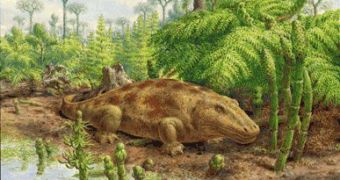Today's Antarctica is the most inhospitable place on Earth: it detains the records of cold, being covered by the largest ice pack of the planet (that harbors 90 % of the ice on Earth), haunted almost all year round by chilly winds.
Moreover, it is also the most isolated continent, located at thousands of kilometers away from the closest land masses.
But this situation was not like that since ever.
New fossilized remains of an amphibian which roamed the Earth more than 245 million years ago have been discovered in Antarctica, suggesting that its clime during much of the Triassic, the Epoch when dinosaurs and the first primitive mammals emerged was remarkably warm.
The 60 cm (24-inch) piece of skull was dug out from thick sandstone at Fremouw Peak in the Transantarctic Mountains, just six degrees away from the South Pole.
The mixed team of European-American paleontologists has assessed the creature as a Parotosuchus, a 2 m (6.5 ft) long giant crocodile-like predator (but it was rather related to modern salamanders) that lived 40 million years before the first dinosaurs appeared, inhabiting lakes and rivers.
Parotosuchus was a type of ancient amphibians belonging to the Temnospondyl group.
These amphibians were covered by scales, unlike the smooth skin of modern amphibians, and probably swam with an eel-like movement.
Previously, scientists found Parotosuchus fossils from sites in Germany, Kazakhstan, Russia and South Africa and this is the most southerly ever found fossil of this group.
The vast areal of Parotosuchus is explained by the fact that the creature lived in an era when Africa and Antarctica must have been joined together in a supercontinent named Pangea.
The team points that the new specimen indicates that factors were mild enough in the late Early or Middle Triassic period to allow a cold-blooded large amphibian to inhabit Pangea's southern margin, even if in a seasonal cycle.

 14 DAY TRIAL //
14 DAY TRIAL //